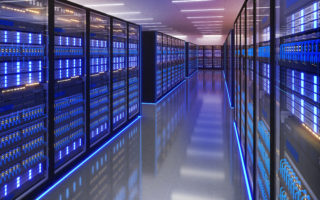
Shot of Data Center With Multiple Rows of Fully Operational Server Racks. Modern Telecommunications, Artificial Intelligence,server room,3d rendering
As we learn to work with new technology, we have to look at the environmental impact and how it affects us in our communities.
This is often an issue when some new digital advancement comes along. One of the most prominent examples is cryptocurrency, where bitcoin mining and other similar blockchain practices use a lot of energy. Specifically, as of 2022, scientists estimated that the practice of mining Bitcoin uses up to 127 terawatt-hours annually, which was roughly equal to the total energy consumption of Norway at the time. To put this in perspective, the average American home uses an estimated 861 kilowatt-hours per month!
It turns out there’s also a significant footprint for ChatGPT and other similar models that we use for search, creativity, professional development, etc.
Just like most pollution, you don’t see the effect right around you. Instead, it builds up. In the case of ChatGPT, the change happens at remote data centers far away from where you’re typing in your parts of the interaction with the neural net.
So what is the actual impact?
Models and Carbon Dioxide Emissions
In terms of carbon dioxide, scientists estimate that ChatGPT emits about 8.4 tons of carbon dioxide annually.
However, when you compare that to one person’s output, it’s about double. So you can imagine that in a total year, ChatGPT only emits as much carbon dioxide as one roving couple of aging nomads in a Volkswagen van.
Or, pick your metaphor.
The point is that taking in the big picture, this isn’t really a lot of carbon dioxide emissions.
Water Use for ChatGPT
The issue becomes a bit more urgent when you consider water use.
Those data centers need a lot of water to operate. Operators need to cool rack after rack of hard-working hardware, that is generating a lot of heat, while consuming those corresponding massive amounts of power.
Here’s where ChatGPT’s footprint is sizable.
Experts estimate that for every 20 to 50 queries you ask ChatGPT, it uses the equivalent of a single bottle of water, around 500 cL.
That means the total water usage is sizable.
You also have to take into account how the energy to power data centers is generated. If it’s generated far from the data center itself, energy is lost in transmission. If it’s from coal burning, that has its own footprint.
This resource from Maricopa Community College makes the distinction between renewable and non-renewable energy sources, showing how they have differing impacts on the environment.
“Renewable energy sources can be replenished within human lifespans. Examples include solar, wind, and biomass energy. Non-renewable energy is finite and cannot be replenished within a human timescale.”
At the same time, many of these renewables also have zero emissions. That is not true, though, of wood, where natural wood combustion creates quite a bit of contamination.
The Air Around You
On a very general level, we have to be cognizant of air pollution, because it can affect our health.
In addition to carbon dioxide, you have factory fumes, particles from wood smoke, and emissions from vehicles, each of which carries its own burdens of PM 2.5, NO2, and other pollutants.
On the blog, you can find a lot of updates about how governments and communities are handling air pollution. You can read about where it’s coming from, for instance, wildfires and their responses all over the globe.
But you can also start trying for cleaner air at home with an air purifier appliance that will scrub out a lot of these pollutants, as well as many others.
As we’ve pointed out, you’re dealing with a range of air pollutants. Some of them are synthetic chemicals, and others more natural. Air purifiers can work on things like mold, dust mites, and pet dander or pet odor. They can also work on volatile organic compounds (VOCs) like formaldehyde and benzene, and they can work on PM 2.5 from wood or coal combustion, or vehicle exhaust.
One good way to start is using an air monitor to see what’s lurking in your indoor air.
Then you can use a whole home or floor-standing air purifier to remediate the issue and get clean, livable, breathable air.